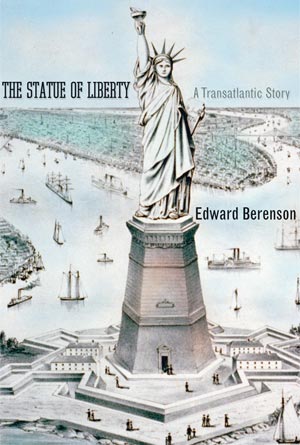
The Statue of Liberty tells the story of America’s most beloved icon, the symbol, we like to think, of our openness to the world. But how many Americans know that Lady Liberty had essentially nothing to do with immigration when she first went up? That xenophobes used the statue as a symbol before pro-immigration forces did? That Emma Lazarus’s poem about the “Huddled Masses,” written in 1883, remained little known until the 1930s? The Statue of Liberty is at once familiar and unknown, commonplace and full of surprises.
The statue is surprising in part because its meaning has changed from one generation to the next. Ever since the first images appeared in the mid-1870s, even before construction in Paris had begun, the colossus of New York Harbor has been an open figurative screen, a massive sculpted form onto which an endless variety of ideas, values, intentions, and emotions could be projected. It has come to signify both liberty and subjection, immigration and xenophobia, the lure of America and its dangerous shoals, the dangers of terrorism and the resilience of New York City and the United States in the wake of 9/11.
Our extremely fluid understanding of what the statue says comes from three of its essential qualities: abstractness, artistic banality, and colossal size.
Its creator, Frédéric Auguste Bartholdi, intended the Statue of Liberty to last many decades, even centuries, and wanted it to express a general, universal theme. He thus gave it a classical form, one that had endured since ancient times. He kept it abstract and allegorical rather having it represent a particular individual or historical event. Except for the barely-visible “July 4, 1776” inscribed on its tablet, the Statue of Liberty doesn’t even overtly refer to the United States.
Like its abstractness, the Statue of Liberty’s artistic banality—its conservatism of form—is related to its need to survive political and cultural change. Bartholdi himself admitted that his statue “cannot be considered as a very great work of art.” But its neutral neoclassicism allowed it to elude passionate aesthetic attack and gave it the potential to represent a great many different things.
Finally, the statue’s colossal size and strategic location guaranteed that it would continue to draw attention and thus retain the ability to encourage people to confer meaning on it, whether for political, social, or commercial purposes.
My intellectual trajectory in coming to this book stems from my longstanding interest in France.
I’m an American who has studied France and its history for the past 30 years. I was born in America and developed something of a second identity in France; the Statue of Liberty was born in France, with a second—and eventually dominant—identity in the United States.
Some years back, I discovered a number of surprising things about the Statue of Liberty while writing an article about American views of the French Republic. Like most people, I thought the Statue of Liberty was a gift from France to United States. In fact, neither government had much to do with it. Napoleon III, the French ruler at the time Liberty was conceived, actively opposed the idea. The U.S. government, for its part, refused to put up a single dollar, even though the project’s American supporters had promised that their country would fund the Statue of Liberty’s tall, granite-faced pedestal.
Napoleon III knew that the Frenchmen who created the Statue of Liberty meant it as a critique of his authoritarian government. In this country, the statue at first seemed an alien import, a symbol not of liberty but of the putative horrors of the Paris Commune, a powerful urban insurrection that engulfed the French capital in the of spring 1871. Karl Marx dubbed the Commune the world’s first proletarian revolt. Perhaps for that reason, certain conservative Americans considered Bartholdi’s colossal goddess a Trojan horse and feared, as one writer put it, that “the red-fool fury of the Seine” would take up residence in the United States.
I hope browsers will look at the book’s prologue, since I open the story by describing an excursion to the Statue of Liberty, my first trip there since my 6th grade.
Our “mother of the harbor,” as Emma Lazarus called her, attracts more than three million visitors a year—but few of them are New Yorkers like me. Those who take the ferry to the Statue of Liberty and then climb to the top must endure security procedures far more rigorous than at any airport. As I waited in the long security line snaking slowly toward the dock, I thought about what a choice terrorist target Lady Liberty would be and about the ways her symbolism has changed since the terrible attacks of ten years ago. With the lower Manhattan skyline now cut low, the Statue of Liberty stands all the more prominently as the symbol of New York and gateway to the United States.
As America’s most visible icon, the Statue of Liberty has always been vulnerable to commercial and political exploitation. A great many advertisers have used it to hawk their products; politicians have made it a backdrop for their campaigns; celebrities, souvenir makers, and even a Las Vegas casino have had it serve their own unlofty designs. Last fall, Lady Gaga joined in, appearing on a prominent magazine cover as a bikini-clad Statue of Liberty, her hair teased into the seven spokes of Liberty’s crown.
But despite these often crass and kitschy assaults, Bartholdi’s great green goddess has shrugged off every attempt to debase it. Thanks to her timeless Neoclassical design and spectacular perch in New York harbor, the Statue of Liberty has maintained its dignity, its ability to represent cherished values and ideals. If Lady Gaga can’t trivialize Lady Liberty, nothing can.


Edward Berenson has been a professor of history for thirty years, first at the UCLA and now at NYU, where he is also Director of the Institute of French Studies. Besides The Statue of Liberty and Heroes of Empire, featured on Rorotoko, Berenson is the author or editor of Populist Religion and Left-wing Politics in France, The Trial of Madame Caillaux, Constructing Charisma (with Eva Giloi), and The French Republic: History, Values, Debates (with Vincent Duclert and Christophe Prochasson).